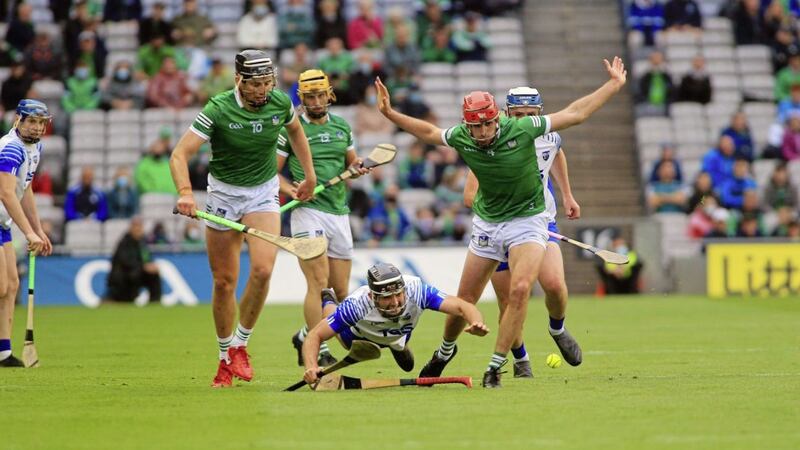IT wasn’t that long ago that hurling was dead, no more, ceased to be, etc, etc.
A couple of weeks into the National League, Limerick manager John Kiely wondered if you were allowed to tackle any more, which prompted pundit and former Kilkenny star Jackie Tyrrell to agree and sound the clanging chimes of doom - the game had turned into a “gloried free-taking competition.”
That criticism from within seemed to give permission for a pile on from people who ordinarily don’t pay that much attention to hurling as their eyes are usually elsewhere, focussed on a bigger ball.
Those sorts of extreme reactions - and you could easily reverse the roles with football being condemned for all time - are now standard when it comes to sport, and just about anything.
There’s no middle ground. It’s either the best thing in the world or the worst. Actually, the worst thing in the world seems to be daring to suggest “I don’t know” as an option. Where falling somewhere in the middle somehow makes you an outlier.
Even being uninterested needs to be done with all guns blazing.
High up in the replies to just about any social media post you’ll find someone has gone to trouble of pointing out, entirely without irony, that “no-one cares”.
So a couple of matches with a lot of frees right at the start of the season were seen as a portent of the end of the game.
But after that blast of sound and fury the strangest thing happened.
Hurling came back to life quietly, just by getting on with it. The minimum of fuss in a world where that doesn’t seem possible.
The Championship has been a good one and the final has the potential to be a classic. To be fair, there’s about an equal chance that Limerick run over Cork like a train, but that’s another story.
Whether or not the GAA had another word with referees – this time to tell them cool their jets a bit – or the game simply shook off the rust that came with a Covid-enforced barely-there pre-season, throughout the League and into the Championship the ship slowly but surely righted itself.
Some will say it’s still taking on water - this isn’t an argument that it’s healthy everywhere it should be in the country, because it clearly isn’t - but the game itself, the nuts and bolts of how it’s played, is entirely sound.
Whether or not that’s a particular person’s cup of tea is something quite different.
Some of the sticks used to beat the game with are entirely subjective matters of taste.
Neither Kiely’s nor Tyrrell’s criticisms fell into that category but they were used as a jumping off point for some recurring gripes.
A popular one is that there are “too many points” or “it’s too easy to score”.
I’ve found myself watching a lot of hurling matches from the late 80s and early 90s recently, when scorelines didn’t come close to what they do now.
That’s because the players didn’t hit the ball as far or as accurately. Shots were still taken but far more dropped short or went wide.
These weren’t unskilled players – some of them were as good as anyone who’s played the game - but so many factors have changed since then that to judge modern hurling by those standards, or vice versa, is pointless.
Conditioning and equipment are the big two.
Players, coached to be immensely skilful anyway, are bigger, stronger, fitter and faster. But that’s what happens in all sports.
Everybody’s stick these days really does look like a frying pan by comparison, and the sliotars are undoubtedly lighter and easier to control than they were 30 years ago.
The big change in just the past 10 or 15 years, noted recently by former Galway goalkeeper James Skehill is not weight but the fact you’d be hard pressed to find a ball with the mandated minimum 2mm high by 3.6mm wide rim, a key factor in the ball’s flight and the ability to control it off the stick. Modern sliotars are closer to tennis balls – and not just because they’re yellow.
But if 30-point totals are now the norm, does it really matter? Would a match be better if both teams had 15 fewer points, 10 more wides and five more dropped into the ’keepers hand? If your measuring stick for quality – or enjoyment – is difficulty of scoring you may be looking too hard to find something to complain about in something you’re not that fussed on in the first place.
Much of the problem is the proximity of Gaelic football. Apart from the same playing area, posts and traditional line-ups, the games are as about as alike as soccer and the last 20 minutes of Escape to Victory.
It works both ways, with hurling snobs – a very real, utterly pointless, phenomenon – spending the past decade and more only noticing football just long enough to snark at it when a big match turned into, another mortal sin, a low-scoring stinker.
Over the past couple of years, any time a man running through in a hurling match was dragged to the ground football folk took great delight in wondering why it was so special that it didn’t need a black card. In response, hurling folk would wonder why football ideas should pollute their game.
It's turned out that the black card/sin bin/penalty combination has worked extremely well in hurling.
There have been problems with consistency – but if there weren’t it wouldn’t be a GAA rule, would it?
A lack of goals in hurling has been a fair enough complaint. They’ve always been a great part of the game and the numbers have gone back up, in no small part thanks to a sensible change to the rule book.
The game itself has changed – and will change again. If it hasn’t changed to your liking, fine, that doesn’t mean there’s anything wrong with it. And if you claim not to care in the first place, then what have you read all the way to the bottom of this for?








